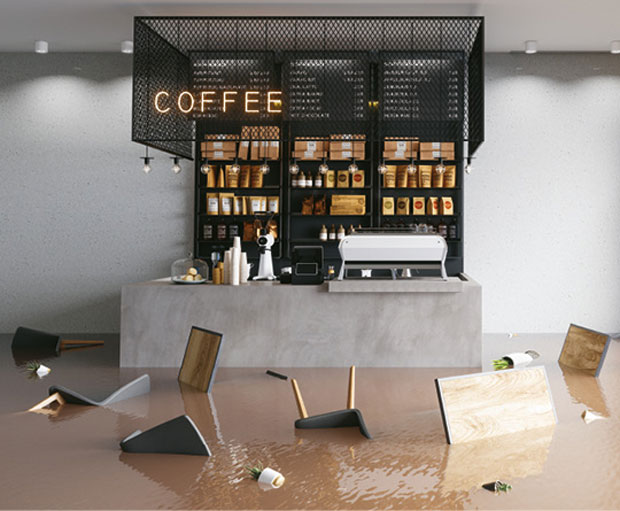Climate change means it has never been more important to assess site drainage risks and take steps to control them, says Kevin Moon, Managing Director of drainage and wastewater specialist Lanes Group plc
Here in the UK we’re used to a variety of weather, but climate change is making that variety ever more extreme. That brings significant challenges as flooding does not just involve rivers bursting their banks or waves breaching sea defences. Overwhelmed surface drains and sewers often contribute to localised flooding.
The following six-step checklist can form the basis of a timely site drainage resilience review:
Know your flood risks
Is your property in a location that is at particular risk of localised flooding? Just because a property has not flooded before, it does not mean it will not flood in the future.
Flood risks change over time. It is possible that the Environment Agency or your Local Flood Authority has recently put in measures to reduce flood risks in your business area. Or, changing local conditions may have increased risks.
It may be worth using flood risk checker services operated by UK governments. You can also sign up to receive local flood alerts. Where necessary, taking advice from a hydrologist may be advisable.
Assess your drainage system
Do you have an accurate and up-to-date map of your site drainage? Site drainage systems can be developed over decades. Records are often piecemeal and inaccurate and only when you have an accurate site drainage map can you begin to assess its condition, capacity and fitness for purpose, now and into the future.
These issues can only be properly addressed by commissioning a drainage specialist to carry out a full site CCTV drainage survey. This will show where remedial action may be needed to address faults that increase flooding risks.
It will also help you assess if your drainage system complies with pollution regulations. With localised flood risks increasing in many areas, this could be vital, to prevent your first flooding incident also being the first appearance in court for pollution offences.
Planned preventative maintenance (PPM)
In the long-term, preventing flooding is less costly than clearing up after it has occurred. Therefore, having a PPM schedule in place makes the best sense. Surface water interceptors must be cleaned and emptied regularly to ensure they are doing their job of capturing potential pollutants.
System cleaning and flushing will reduce the risk of floods disrupting business activities in ways that are commercially and reputationally harmful. It also protects drains against deterioration, for example through root ingress.
Address current site drainage problems
If you are already experiencing drainage problems, now is the time to deal with them. If sinks and toilets are not emptying quickly, wastewater may be building up inside pipes behind blockages. Water pooling on hard surfaces may indicate blockages or breakages in surface water drains.
This is particularly common across parking or access areas, where the weight and vibration effects of vehicles can contribute to drain collapses.
Different sites have different drainage problems. For shopping and leisure centres, sewers are often compromised by toilet misuse, through the wrongful flushing of wipes and nappies.
Disposal of fats, oils and grease (FOG) and waste food down sinks and drains, in particular by restaurants and food producers, are frequent causes of drainage blockages.
Both can lead to localised internal and external flooding. Customer and staff awareness campaigns within such facilities may help reduce this problem.
Assess wider drainage issues
Business sites may be at risk of flooding due to offsite issues – for example if a local water course is blocked. Understanding these issues and raising them, in a timely way, with relevant authorities and property owners is an important step.
Prepare an emergency plan
Businesses must also be ready if the worst does happen. Ensuring a site flood response plan is built into business continuity planning is vital.
Having rapid access to a reputable drainage specialist, preferably one that understands your site drainage from carrying out PPM work, is likely to be beneficial.
CLIMATE CHANGE – A NEW DIMENSION
Climate change is creating new drainage challenges where the condition of site drainage systems can change more rapidly than in previous, less volatile, times.
Just like clean water pipes, surface water drains and sewers can be affected by the seasonal contraction and expansion of clay soils, resulting in pipe joints being displaced, pipes cracking or collapsing.
This problem is expected to become more commonplace due to climate change, with northern areas of the UK increasingly affected for the first time due to changing weather patterns.
During prolonged periods of dry weather, tree root systems grow more aggressively, increasing the risk of root infestation in drainage pipes.
Low flow rates in drainage channels during dry weather allow solid material and debris to build up, increasing the risk of flooding when the rains return.
In line with the government’s national flood strategy, there are three important elements to site drainage planning – protection, resilience, adaptation. So assess the risks, including through CCTV drainage surveying, put in place PPM systems, and improve site drainage where necessary. Otherwise, your sites may be exposed to unacceptable risk of serious flooding events and the far greater costs they would incur.





